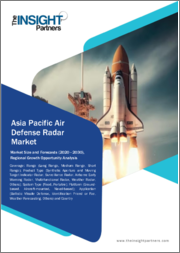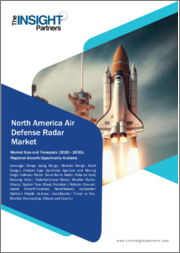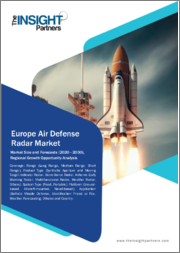
|
시장보고서
상품코드
1420206
아시아태평양의 방공 레이더 시장 : 지역별 분석 - 범위별, 제품 유형별, 시스템 유형별, 플랫폼별, 용도별, 예측(-2030년)Asia Pacific Air Defense Radar Market Forecast to 2030 - Regional Analysis - by Range, Product Type, System Type, Platform, and Application |
||||||
아시아태평양의 방공 레이더 시장 규모는 2022년 16억 8,166만 달러에 달할 것으로 예상되며, 2022-2030년 연평균 5.9% 성장하여 2030년에는 26억 6,998만 달러에 달할 것으로 전망됩니다.
소형화 및 저가형 레이더 시장 개척으로 아시아태평양의 방공 레이더 시장 성장 촉진
레이더의 소형화 및 저비용화는 반도체 제조 공정의 개선과 관련 부품의 소형화 등 기술 발전에 따른 것입니다. 이러한 발전은 기존 레이더 시스템에 비해 성능 저하 없이 더 작고 가볍고 비용 효율적인 레이더 시스템 및 소형화된 레이더 시스템을 개발할 수 있게 해줍니다. 소형화된 형태는 접근성을 높이고 다양한 운영 요건과 환경에 적응할 수 있도록 해줍니다. 이러한 특징은 지상 시스템, 함정, 무인 항공기(UAV) 등 다양한 플랫폼에 레이더를 쉽게 통합할 수 있게 해줍니다. 소형화 레이더의 유연성과 적응성은 다양한 운영 환경에 적합하여 시장 잠재력을 확장하고 있습니다. 또한 다양한 시장 참여자들은 방공 레이더 시스템의 비용 효율성에 더 많은 초점을 맞추었습니다. 예를 들어, 다기능 레이더 시스템과 같은 레이더 시스템은 여러 레이더 기능을 단일 플랫폼에 통합하여 운영 효율성을 높입니다. 단일 시스템에서 여러 작업을 수행할 수 있기 때문에 운영 효율성과 비용 효율성이 향상됩니다. 이 때문에 시장에서는 소형화 및 저비용화가 진행되고 있습니다.
아시아태평양의 방공 레이더 시장 개요
아태지역 방공 레이더 시장은 괄목할 만한 성장세를 보이고 있습니다. 아시아태평양의 긴장과 지정학적 역학관계 증가로 인해 아시아태평양 국가들은 국방력을 강화하고 있습니다. 이에 따라 국가 안보와 영토 보호를 위해 레이더를 포함한 첨단 방공 시스템에 대한 수요가 증가하고 있습니다. 또한, 기존 방공 시스템의 급속한 현대화 및 업그레이드 계획이 아시아태평양의 방공 레이더 시장을 주도하고 있습니다. 이 지역의 많은 국가들은 진화하는 위협 상황에 대응하기 위해 군사 장비 업그레이드에 많은 투자를 하고 있습니다. 레이더 시스템 업그레이드는 미사일, 항공기, 드론과 같은 공중 위협을 조기에 탐지, 추적 및 요격할 수 있기 때문에 이러한 현대화 노력의 중요한 측면입니다. 아시아태평양은 군사 기술에 아낌없이 투자하고 있습니다. 예를 들어, 2022년 아시아태평양의 주요 국가들은 군사 기술에 5,414억 달러를 투자했습니다. 복수의 군사 소식통에 따르면, 이 지역은 2023년 1,312척 이상의 함정을 보유하고 있습니다. 또한 중국, 인도, 일본, 한국 등 국가들은 지역 전체에서 향후 조달을 위해 약 52척의 해군 함정을 공동 발주했습니다. 이는 함정용 방공 레이더 시스템에 대한 수요를 더욱 증가시킬 것입니다.
AESA(Active Electronic Scanning Array)와 같은 레이더 기술의 발전은 탐지 능력 강화, 작전 범위 확대, 목표물 추적 정확도 향상을 가져왔습니다. 이러한 기술 발전으로 아시아태평양에서는 차세대 방공 레이더 시스템에 대한 수요가 급증하고 있습니다. 또한 비대칭 전쟁, 테러, 사이버 위협과 같은 비전통적 안보 위협 증가는 강력한 방공 레이더 시스템의 필요성을 더욱 부추기고 있습니다. 각국 정부는 재래식 및 비전통적 위협을 포괄하는 종합적인 방어 전략을 수립하기 위해 노력하고 있으며, 이는 첨단 레이더 기술에 대한 투자 증가로 이어지고 있습니다. 이 지역 국가들의 경제 발전과 국방 예산 증가도 아시아태평양의 방공 레이더 시장의 성장을 뒷받침하고 있습니다. 중국, 인도, 일본, 한국 등 많은 국가들이 방공 시스템을 포함한 방공 능력 강화에 많은 자금을 할당하고 있습니다. 이러한 재정적 투입은 아시아태평양의 방공 레이더 시장 성장에 유리한 환경을 조성하고 있습니다.
아시아태평양의 방공 레이더 시장 매출 및 2030년까지의 예측(백만 달러)
아태지역 방공 레이더 시장 세분화
아시아태평양의 방공 레이더 시장은 기능, 범위, 시스템 유형, 플랫폼, 용도, 국가별로 분류됩니다.
기능별로 아시아태평양의 방공 레이더 시장은 합성개구레이더 및 이동표적 지시레이더, 감시레이더, 항공 조기경보레이더, 다기능레이더, 기상레이더, 기타로 구분되며, 2022년 아시아태평양의 방공 레이더 시장에서 합성개구레이더 및 이동표적 지시레이더 분야가 가장 큰 비중을 차지할 것으로 예상됩니다. 지시 레이더 분야가 큰 비중을 차지하고 있습니다.
사거리를 기준으로 아시아태평양의 방공 레이더 시장은 단거리, 중거리, 장거리로 구분되며, 2022년 아시아태평양의 방공 레이더 시장에서 중거리 부문이 가장 큰 점유율을 차지할 것으로 예상됩니다.
시스템 유형에 따라 아시아태평양의 방공 레이더 시장은 고정형 레이더와 휴대용 레이더로 구분되며, 2022년 아시아태평양의 방공 레이더 시장에서 고정형 레이더 분야가 가장 큰 점유율을 차지할 것으로 예상됩니다.
플랫폼별로 아시아태평양의 방공 레이더 시장은 지상 기반, 항공기 탑재, 해군 기반으로 구분되며, 2022년 아시아태평양의 방공 레이더 시장에서 지상 기반 부문이 가장 큰 점유율을 차지할 것으로 예상됩니다.
용도별로 아시아태평양의 방공 레이더 시장은 탄도 미사일 방어, 적군 식별, 기상 예측, 기타로 구분됩니다. 적군 식별 분야는 2022년 아시아태평양의 방공 레이더 시장에서 가장 큰 점유율을 차지할 것으로 예상됩니다.
국가별로 아시아태평양의 방공 레이더 시장은 호주, 중국, 인도, 일본, 한국, 기타 아시아태평양으로 구분되며, 2022년 아시아태평양의 방공 레이더 시장은 중국이 독점했습니다.
BAE Systems Plc, General Dynamics Corp, Honeywell International Inc, Israel Aerospace Industries Ltd, Leonardo SpA, Lockheed Martin Corp, Northrop Grumman Corp, Raytheon Technologies Corp, Saab AB, Thales SA는 아시아태평양의 방공 레이더 시장에서 사업을 운영하는 주요 기업 중 일부입니다.
목차
제1장 서론
제2장 주요 요약
- 주요 인사이트
- 시장의 매력
제3장 조사 방법
- 범위
- 2차 조사
- 1차 조사
제4장 아시아태평양의 방공 레이더 시장 구도
- Porter의 Five Forces 분석
- 생태계 분석
- 원재료 및 컴포넌트 공급업체
- 방공 레이더 제조업체
- 시스템 통합사업자 및 소프트웨어 개발자
- 최종사용자
제5장 아시아태평양의 방공 레이더 시장 : 주요 산업 역학
- 시장 성장 촉진요인
- 시장 성장 억제요인
- 시장 기회
- 향후 동향
- 성장 촉진요인과 억제요인의 영향 분석
제6장 방공 레이더 시장 : 아시아태평양 시장 분석
- 아시아태평양의 방공 레이더 시장 매출 점유율 : 지역별(2020년·2030년)
- 아시아태평양의 방공 레이더 시장 매출 추이(2020-2030년)
제7장 아시아태평양의 방공 레이더 시장 분석 : 제품 유형별
- 아시아태평양의 방공 레이더 시장 매출 점유율 : 제품 유형별(2022년·2030년)
- 합성 개구 레이더·이동 목표 표시 레이더
- 감시 레이더
- 항공 조기 경계 레이더
- 다기능 레이더
- 기상 레이더
- 기타
제8장 아시아태평양의 방공 레이더 시장 분석 : 범위별
- 아시아태평양의 방공 레이더 시장 매출 점유율 : 범위별(2022년·2030년)
- 단거리
- 중거리
- 장거리
제9장 아시아태평양의 방공 레이더 시장 분석 : 시스템 유형
- 아시아태평양의 방공 레이더 시장 매출 점유율 : 시스템 유형별(2022년·2030년)
- 고정 레이더
- 휴대용 레이더
제10장 아시아태평양의 방공 레이더 시장 분석 : 플랫폼
- 아시아태평양의 방공 레이더 시장 매출 점유율 : 플랫폼별(2022년·2030년)
- 지상 기반
- 항공기 탑재형
- 해군 기반
제11장 아시아태평양의 방공 레이더 시장 분석 : 용도별
- 아시아태평양의 방공 레이더 시장 매출 점유율 : 용도별(2022년·2030년)
- 탄도 미사일 방위
- 우군 식별
- 기상 예측
- 기타
제12장 아시아태평양의 방공 레이더 시장 : 국가별 분석
- 아시아태평양
- 호주
- 중국
- 인도
- 일본
- 한국
- 기타 아시아태평양
제13장 COVID-19 전후의 영향
- COVID-19 전후의 영향
제14장 경쟁 구도
- 주요 기업별 히트맵 분석
- 기업 포지셔닝과 집중도
제15장 산업 상황
- 시장 이니셔티브
- 인수합병(M&A)
- 신규 개발
제16장 기업 개요
- BAE Systems Plc
- General Dynamics Corp
- Honeywell International Inc
- Israel Aerospace Industries Ltd
- Leonardo SpA
- Lockheed Martin Corp
- Northrop Grumman Corp
- Raytheon Technologies Corp
- Saab AB
- Thales SA
제17장 부록
LSH 24.02.16The Asia Pacific air defense radar market is expected to grow from US$ 1,681.66 million in 2022 to US$ 2,669.98 million by 2030. It is estimated to grow at a CAGR of 5.9% from 2022 to 2030.
Development of Miniaturized and Low-Cost Radars Fuel the Asia Pacific Air Defense Radar Market
The development of miniaturized and low-cost radars is due to technological advancements, such as improved semiconductor manufacturing processes and the miniaturization of associated components. These advancements enable the development of smaller, lighter, and more cost-effective radar systems or miniaturized radar systems compared to traditional ones without compromising performance. Their compact form makes them more accessible and adaptable to different operational requirements and environments. This feature also allows easier integration of radars into various platforms, such as ground-based systems, naval vessels, or unmanned aerial vehicles (UAVs). The flexibility and adaptability of miniaturized radars make them suitable for diverse operational environments, expanding their market potential. Further, the various market players are focusing more on the cost efficiency of the air defense radar systems. For instance, radar systems such as multifunction radar systems offer enhanced operational efficiency by integrating multiple radar capabilities into a single platform. The ability to perform multiple tasks with a single system increases operational efficiency and cost-effectiveness. Thus, the market is witnessing the growing trend of miniaturized and low-cost radars development.
Asia Pacific Air Defense Radar Market Overview
The air defense radar market in Asia Pacific (APAC) is experiencing significant growth. The increasing regional tensions and geopolitical dynamics have led countries in Asia Pacific to enhance their defense capabilities. As a result, there is a growing demand for advanced air defense systems, including radars, to safeguard national security and territorial integrity. Moreover, rapid modernization and upgrade programs for existing air defense systems drive the Asia Pacific Air Defense Radar Market. Many countries in the region are investing heavily in upgrading their military equipment to match the evolving threat landscape. Upgrading radar systems is a crucial aspect of this modernization effort, as it enables early detection, tracking, and interception of aerial threats such as missiles, aircraft, and drones. APAC is investing generously in military technologies. For instance, in 2022, major countries in APAC (considered in the scope) invested US$ 541.4 billion in military technology. According to several military sources, the region accounted for more than 1,312 naval vessels in 2023. Also, countries such as China, India, Japan, and South Korea collaboratively commissioned ~52 naval vessels for future procurement across the region. This will further generate demand for air defense radar systems for naval vessels.
Advancements in radar technologies, such as active electronically scanned arrays (AESAs), have provided enhanced detection capabilities, increased operational range, and improved target tracking accuracy. These technological advancements have generated a surge in demand for next-generation air defense radar systems in Asia Pacific. Moreover, the rise of nontraditional security challenges, such as asymmetric warfare, terrorism, and cyber threats, has fueled the need for robust air defense radar systems. Governments are keen to develop comprehensive defense strategies encompassing conventional and unconventional threats, leading to increased investments in advanced radar technologies. Economic development and rise in defense budgets of countries in the region also support the growth of the Asia Pacific Air Defense Radar Market. Many countries, including China, India, Japan, and South Korea, have allocated substantial funds to enhance their defense capabilities, including air defense systems. This financial commitment has created a favorable environment for the growth of the Asia Pacific air defense radar market.
Asia Pacific Air Defense Radar Market Revenue and Forecast to 2030 (US$ Million)
Asia Pacific Air Defense Radar Market Segmentation
The Asia Pacific air defense radar market is segmented into function, range, system type, platform, application, and country.
Based on function, the Asia Pacific air defense radar market is segmented into synthetic aperture radar and moving target indicator radar, surveillance radar, airborne early warning radar, multi-functional radar, weather radar, and others. The synthetic aperture radar and moving target indicator radar segment held a larger share of the Asia Pacific air defense radar market in 2022.
Based on range, the Asia Pacific air defense radar market is segmented into short range, medium range, and long range. The medium range segment held the largest share of the Asia Pacific air defense radar market in 2022.
Based on system type, the Asia Pacific air defense radar market is segmented into fixed radar, and portable radar. The fixed radar segment held the largest share of the Asia Pacific air defense radar market in 2022.
Based on platform, the Asia Pacific air defense radar market is segmented into ground-base, aircraft-mounted, and naval based. The ground-base segment held the largest share of the Asia Pacific air defense radar market in 2022.
Based on application, the Asia Pacific air defense radar market is segmented into ballistic missile defense, identification friend or foe, weather forecasting, and others. The identification friend or foe segment held the largest share of the Asia Pacific air defense radar market in 2022.
Based on country, the Asia Pacific air defense radar market is segmented int o Australia, China, India, Japan, South Korea, and the Rest of Asia Pacific. China dominated the Asia Pacific air defense radar market in 2022.
BAE Systems Plc, General Dynamics Corp, Honeywell International Inc, Israel Aerospace Industries Ltd, Leonardo SpA, Lockheed Martin Corp, Northrop Grumman Corp, Raytheon Technologies Corp, Saab AB, and Thales SA are some of the leading companies operating in the Asia Pacific air defense radar market.
Reasons to Buy:
- Save and reduce time carrying out entry-level research by identifying the growth, size, leading players, and segments in the Asia Pacific Air Defense Radar Market.
- Highlights key business priorities in order to assist companies to realign their business strategies.
- The key findings and recommendations highlight crucial progressive industry trends in Asia Pacific Air Defense Radar Market, thereby allowing players across the value chain to develop effective long-term strategies.
- Develop/modify business expansion plans by using substantial growth offering developed and emerging markets.
- Scrutinize in-depth Asia Pacific Market trends and outlook coupled with the factors driving the market, as well as those hindering it.
- Enhance the decision-making process by understanding the strategies that underpin security interest with respect to client products, segmentation, pricing and distribution.
Table Of Contents
1. Introduction
- 1.1 The Insight Partners Research Report Guidance
- 1.2 Market Segmentation
2. Executive Summary
- 2.1 Key Insights
- 2.2 Market Attractiveness
3. Research Methodology
- 3.1 Coverage
- 3.2 Secondary Research
- 3.3 Primary Research
4. Asia Pacific Air Defense Radar Market Landscape
- 4.1 Overview
- 4.2 Porter's Five Forces Analysis
- 4.3 Ecosystem Analysis
- 4.3.1 Raw Material and Component Suppliers:
- 4.3.2 Air Defense Radar Manufacturers:
- 4.3.3 System Integrators & Software Developers:
- 4.3.4 End Users:
5. Asia Pacific Air Defense Radar Market - Key Industry Dynamics
- 5.1 Key Market Drivers:
- 5.1.1 Rise in Number of Contracts for Supply of Air Defense Radar
- 5.1.2 Continuous Rise in Defense Spending
- 5.1.3 Emergence of Network-Centric and Modern Warfare
- 5.2 Key Market Restraints:
- 5.2.1 Threat of Jamming and Spoofing
- 5.2.2 Decreasing Deployment of Aerostat Radars and Balloon Radars
- 5.3 Key Market Opportunities:
- 5.3.1 Rising Adoption of Unmanned Aerial Vehicles
- 5.3.2 Rise in Cross-Border Conflicts
- 5.4 Future Trend:
- 5.4.1 Development of Miniaturized and Low-Cost Radars
- 5.5 Impact of Drivers and Restraints:
6. Air Defense Radar Market - Asia Pacific Market Analysis
- 6.1 Asia Pacific Air Defense Radar Market Share, By Region (%), 2020 and 2030
- 6.2 Asia Pacific Air Defense Radar Market Revenue (US$ Mn), 2020 - 2030
7. Asia Pacific Air Defense Radar Market Analysis - Product Type
- 7.1 Overview
- 7.2 Asia Pacific Air Defense Radar Market Revenue Share, By Function (2022 and 2030)
- 7.3 Synthetic Aperture Radar & Moving Target Indicator Radar
- 7.3.1 Overview
- 7.3.2 Synthetic Aperture Radar and Moving Target Radar: Asia Pacific Air Defense Radar Market Revenue and Forecast to 2030 (US$ Million)
- 7.4 Surveillance Radar
- 7.4.1 Overview
- 7.4.2 Surveillance Radar: Asia Pacific Air Defense Radar Market Revenue and Forecast to 2030 (US$ Million)
- 7.5 Airborne Early Warning Radar
- 7.5.1 Overview
- 7.5.2 Airborne Early Warning Radar: Asia Pacific Air Defense Radar Market Revenue and Forecast to 2030 (US$ Million)
- 7.6 Multi-Functional Radar
- 7.6.1 Overview
- 7.6.2 Multi-Functional Radar: Asia Pacific Air Defense Radar Market Revenue and Forecast to 2030 (US$ Million)
- 7.7 Weather Radar
- 7.7.1 Overview
- 7.7.2 Weather Radar: Asia Pacific Air Defense Radar Market Revenue and Forecast to 2030 (US$ Million)
- 7.8 Others
- 7.8.1 Overview
- 7.8.2 Others: Asia Pacific Air Defense Radar Market Revenue and Forecast to 2030 (US$ Million)
8. Asia Pacific Air Defense Radar Market Analysis - Range
- 8.1 Overview
- 8.2 Asia Pacific Air Defense Radar Market Revenue Share, By Range (2022 and 2030)
- 8.3 Short Range
- 8.3.1 Overview
- 8.3.2 Short Range: Asia Pacific Air Defense Radar Market Revenue and Forecast to 2030 (US$ Million)
- 8.4 Medium Range
- 8.4.1 Overview
- 8.4.2 Medium Range: Asia Pacific Air Defense Radar Market Revenue and Forecast to 2030 (US$ Million)
- 8.5 Long Range
- 8.5.1 Overview
- 8.5.2 Long Range: Asia Pacific Air Defense Radar Market Revenue and Forecast to 2030 (US$ Million)
9. Asia Pacific Air Defense Radar Market Analysis - System Type
- 9.1 Overview
- 9.2 Asia Pacific Air Defense Radar Market Revenue Share, By System Type (2022 and 2030)
- 9.3 Fixed Radar
- 9.3.1 Overview
- 9.3.2 Fixed Radar: Asia Pacific Air Defense Radar Market Revenue and Forecast to 2030 (US$ Million)
- 9.4 Portable Radar
- 9.4.1 Overview
- 9.4.2 Portable Radar: Asia Pacific Air Defense Radar Market Revenue and Forecast to 2030 (US$ Million)
10. Asia Pacific Air Defense Radar Market Analysis - Platform
- 10.1 Overview
- 10.2 Asia Pacific Air Defense Radar Market Revenue Share, By Platform (2022 and 2030)
- 10.3 Ground-Base
- 10.3.1 Overview
- 10.3.2 Ground-Base: Asia Pacific Air Defense Radar Market Revenue and Forecast to 2030 (US$ Million)
- 10.4 Aircraft-Mounted
- 10.4.1 Overview
- 10.4.2 Aircraft-Mounted: Asia Pacific Air Defense Radar Market Revenue and Forecast to 2030 (US$ Million)
- 10.5 Naval Based
- 10.5.1 Overview
- 10.5.2 Naval Based: Asia Pacific Air Defense Radar Market Revenue and Forecast to 2030 (US$ Million)
11. Asia Pacific Air Defense Radar Market Analysis - Application
- 11.1 Overview
- 11.2 Asia Pacific Air Defense Radar Market Revenue Share, By Application (2022 and 2030)
- 11.3 Ballistic Missile Defense
- 11.3.1 Overview
- 11.3.2 Ballistic Missile Defense: Asia Pacific Air Defense Radar Market Revenue and Forecast to 2030 (US$ Million)
- 11.4 Identification Friend or Foe
- 11.4.1 Overview
- 11.4.2 Identification Friend or Foe: Asia Pacific Air Defense Radar Market Revenue and Forecast to 2030 (US$ Million)
- 11.5 Weather Forecasting
- 11.5.1 Overview
- 11.5.2 Weather Forecasting: Asia Pacific Air Defense Radar Market Revenue and Forecast to 2030 (US$ Million)
- 11.6 Others
- 11.6.1 Overview
- 11.6.2 Others: Asia Pacific Air Defense Radar Market Revenue and Forecast to 2030 (US$ Million)
12. Asia Pacific Air Defense Radar Market - Country Analysis
- 12.1 Asia Pacific Air Defense Radar Market
- 12.1.1 Asia Pacific: Asia Pacific Air Defense Radar Market, by Key Country
- 12.1.1.1 Australia: Asia Pacific Air Defense Radar Market Revenue and Forecasts to 2030 (US$ Million)
- 12.1.1.1.1 Australia: Asia Pacific Air Defense Radar Market, By Product Type
- 12.1.1.1.2 Australia: Asia Pacific Air Defense Radar Market, By Range
- 12.1.1.1.3 Australia: Asia Pacific Air Defense Radar Market, By System Type
- 12.1.1.1.4 Australia: Asia Pacific Air Defense Radar Market, By Platform
- 12.1.1.1.5 Australia: Asia Pacific Air Defense Radar Market, By Application
- 12.1.1.2 China: Asia Pacific Air Defense Radar Market Revenue and Forecasts to 2030 (US$ Million)
- 12.1.1.2.1 China: Asia Pacific Air Defense Radar Market, By Product Type
- 12.1.1.2.2 China: Asia Pacific Air Defense Radar Market, By Range
- 12.1.1.2.3 China: Asia Pacific Air Defense Radar Market, By System Type
- 12.1.1.2.4 China: Asia Pacific Air Defense Radar Market, By Platform
- 12.1.1.2.5 China: Asia Pacific Air Defense Radar Market, By Application
- 12.1.1.3 India: Asia Pacific Air Defense Radar Market Revenue and Forecasts to 2030 (US$ Million)
- 12.1.1.3.1 India: Asia Pacific Air Defense Radar Market, By Product Type
- 12.1.1.3.2 India: Asia Pacific Air Defense Radar Market, By Range
- 12.1.1.3.3 India: Asia Pacific Air Defense Radar Market, By System Type
- 12.1.1.3.4 India: Asia Pacific Air Defense Radar Market, By Platform
- 12.1.1.3.5 India: Asia Pacific Air Defense Radar Market, By Application
- 12.1.1.4 Japan: Asia Pacific Air Defense Radar Market Revenue and Forecasts to 2030 (US$ Million)
- 12.1.1.4.1 Japan: Asia Pacific Air Defense Radar Market, By Product Type
- 12.1.1.4.2 Japan: Asia Pacific Air Defense Radar Market, By Range
- 12.1.1.4.3 Japan: Asia Pacific Air Defense Radar Market, By System Type
- 12.1.1.4.4 Japan: Asia Pacific Air Defense Radar Market, By Platform
- 12.1.1.4.5 Japan: Asia Pacific Air Defense Radar Market, By Application
- 12.1.1.5 South Korea: Asia Pacific Air Defense Radar Market Revenue and Forecasts to 2030 (US$ Million)
- 12.1.1.5.1 South Korea: Asia Pacific Air Defense Radar Market, By Product Type
- 12.1.1.5.2 South Korea: Asia Pacific Air Defense Radar Market, By Range
- 12.1.1.5.3 South Korea: Asia Pacific Air Defense Radar Market, By System Type
- 12.1.1.5.4 South Korea: Asia Pacific Air Defense Radar Market, By Platform
- 12.1.1.5.5 South Korea: Asia Pacific Air Defense Radar Market, By Application
- 12.1.1.6 Rest of APAC: Asia Pacific Air Defense Radar Market Revenue and Forecasts to 2030 (US$ Million)
- 12.1.1.6.1 Rest of APAC: Asia Pacific Air Defense Radar Market, By Product Type
- 12.1.1.6.2 Rest of APAC: Asia Pacific Air Defense Radar Market, By Range
- 12.1.1.6.3 Rest of APAC: Asia Pacific Air Defense Radar Market, By System Type
- 12.1.1.6.4 Rest of APAC: Asia Pacific Air Defense Radar Market, By Platform
- 12.1.1.6.5 Rest of APAC: Asia Pacific Air Defense Radar Market, By Application
- 12.1.1.1 Australia: Asia Pacific Air Defense Radar Market Revenue and Forecasts to 2030 (US$ Million)
- 12.1.1 Asia Pacific: Asia Pacific Air Defense Radar Market, by Key Country
13. Pre & Post Covid-19 Impact
- 13.1 Pre & Post Covid-19 Impact
14. Competitive Landscape
- 14.1 Heat Map Analysis By Key Players
- 14.2 Company Positioning & Concentration
15. Industry Landscape
- 15.1 Overview
- 15.2 Market Initiative
- 15.3 Merger and Acquisition
- 15.4 New Development
16. Company Profiles
- 16.1 BAE Systems Plc
- 16.1.1 Key Facts
- 16.1.2 Business Description
- 16.1.3 Products and Services
- 16.1.4 Financial Overview
- 16.1.5 SWOT Analysis
- 16.1.6 Key Developments
- 16.2 General Dynamics Corp
- 16.2.1 Key Facts
- 16.2.2 Business Description
- 16.2.3 Products and Services
- 16.2.4 Financial Overview
- 16.2.5 SWOT Analysis
- 16.2.6 Key Developments
- 16.3 Honeywell International Inc
- 16.3.1 Key Facts
- 16.3.2 Business Description
- 16.3.3 Products and Services
- 16.3.4 Financial Overview
- 16.3.5 SWOT Analysis
- 16.3.6 Key Developments
- 16.4 Israel Aerospace Industries Ltd
- 16.4.1 Key Facts
- 16.4.2 Business Description
- 16.4.3 Products and Services
- 16.4.4 Financial Overview
- 16.4.5 SWOT Analysis
- 16.4.6 Key Developments
- 16.5 Leonardo SpA
- 16.5.1 Key Facts
- 16.5.2 Business Description
- 16.5.3 Products and Services
- 16.5.4 Financial Overview
- 16.5.5 SWOT Analysis
- 16.5.6 Key Developments
- 16.6 Lockheed Martin Corp
- 16.6.1 Key Facts
- 16.6.2 Business Description
- 16.6.3 Products and Services
- 16.6.4 Financial Overview
- 16.6.5 SWOT Analysis
- 16.6.6 Key Developments
- 16.7 Northrop Grumman Corp
- 16.7.1 Key Facts
- 16.7.2 Business Description
- 16.7.3 Products and Services
- 16.7.4 Financial Overview
- 16.7.5 SWOT Analysis
- 16.7.6 Key Developments
- 16.8 Raytheon Technologies Corp
- 16.8.1 Key Facts
- 16.8.2 Business Description
- 16.8.3 Products and Services
- 16.8.4 Financial Overview
- 16.8.5 SWOT Analysis
- 16.8.6 Key Developments
- 16.9 Saab AB
- 16.9.1 Key Facts
- 16.9.2 Business Description
- 16.9.3 Products and Services
- 16.9.4 Financial Overview
- 16.9.5 SWOT Analysis
- 16.9.6 Key Developments
- 16.10 Thales SA
- 16.10.1 Key Facts
- 16.10.2 Business Description
- 16.10.3 Products and Services
- 16.10.4 Financial Overview
- 16.10.5 SWOT Analysis
- 16.10.6 Key Developments
17. Appendix
- 17.1 Appendix

















